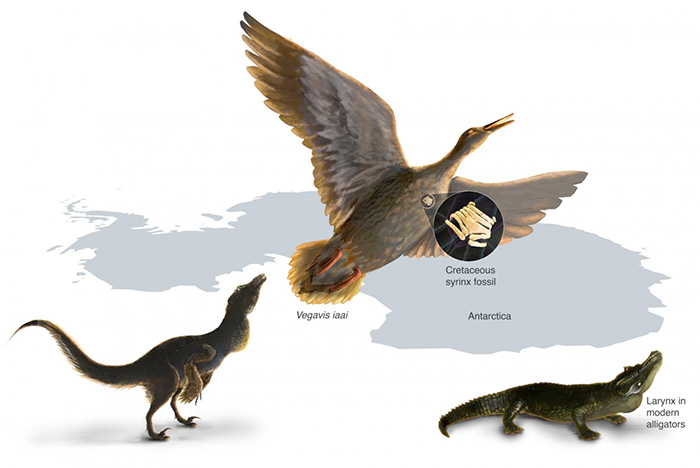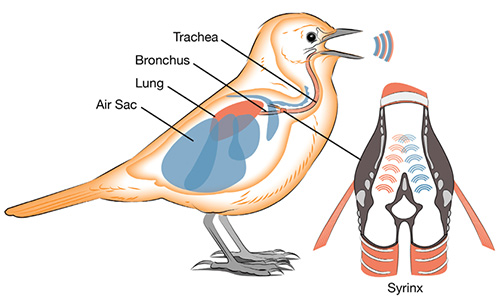
Next time you hear a bird singing, stop for a second to listen. Even the most common birds can do amazing things.
The cardinal, for instance, has the range of a piano, though higher on both ends. And he can span it in a tenth of a second. No human can come close.
The wood thrush can sing one note, a different note on top of that, and trill them both independently. It’s like a soprano duet in one 2-oz animal!
How can they do these incredible things? The secret is their voice box.
Our larynx has one chamber. Theirs, called the syrinx, has two. Ours sits in our throat; theirs, at the base of their trachea. At that location, each chamber has access to a lung.
In this way, the most accomplished bird singers can control each side of their voice box separately, even take small breaths in one side while singing from the other, to keep their song continuous.
If that weren’t enough, some birds know up to 1,000 different songs.
You may remember from a previous EarthDate that for most of Earth’s history, animals couldn’t hear sounds—or make them. So it’s particularly impressive that birds have developed this ability.
In fact, one of the ways we know that ancestors of modern birds lived through the asteroid extinction that wiped out the dinosaurs is that we’ve discovered fossils from before the impact with a voice box similar to those of today.
The syrinx is one of nature’s greatest hits. It may be an oldie, but it’s a goodie.
Background

Credit: Bird Academy
Synopsis: Birds have an amazing two-sided vocal organ that enables them to produce unparalleled melodies—and even harmonies! Around 67 million years ago, some ancient avian dinosaurs developed these organs, and the capability to honk like geese, as they progressively evolved into today’s birds. At the very same time, T. rex ruled Earth but didn’t have the vocal equipment to roar like large mammals, as portrayed in the movies.
- Birds produce all of their sounds, from melodious songs to honks, using their syrinx.
- While the human larynx and vocal cords are found at the top of the trachea, the syrinx is a vocal organ that lies at the base of the bird’s trachea, where it forks into the lungs.
- Able to access an air source from each lung, some songbirds can harmonize with themselves by producing more than one sound at a time!
- Birds can also take mini-breaths during a continuous song to prolong their seemingly uninterrupted performance.
- Like mammalian vocal cords, the membranes in the syrinx vibrate; the pitch and volume are controlled by the tension on the membranes and the force of the air passing through them.
- Stacked mineralized rings of a cartilage-like material anchor the membranes.
- How and when did an amazing vocal organ like this evolve to create the complex and beautiful melodies of songbirds?
- This question is difficult to answer because the delicate membranes and cartilaginous rings of the syrinx are not usually preserved in fossils; however, the high mineral content in the rings sometimes allows for fossilization.
- A few fossil syrinxes from the Holocene and Pleistocene go back about 2.5 million years; another from the Eocene is about 50 million years old.
- In 1992, on Vega Island off the coast of Antarctica, scientists found a beautifully preserved 66–68 million-year-old bird, which they named Vegavis iaai, inside a rock about the size of a cantaloupe.
- This famous fossil settled a long-standing debate by showing scientists that birds did coexist with dinosaurs before the great extinction event at the end of the Cretaceous.
- As technology advanced, paleontologists were able to study finer details of their fossils without destroying their specimens. In 2013, using state-of-the-art 3D CT scanning, UT Austin paleontologist Julia Clarke discovered rings of a tiny, complete syrinx, no bigger than a vitamin pill, within a piece of the fossil from the chest of the bird.
- The asymmetric syrinx suggested that the Vegavis may have used the two sets of vocal membranes as separate sound sources, producing a harmony. The shape of both the bird’s skeleton and its syrinx suggested it looked and honked like a tiny goose.
- Without vocal cords, some dinosaurs may have made close-mouthed booming sounds like ostriches or hissing sounds using forced air.

